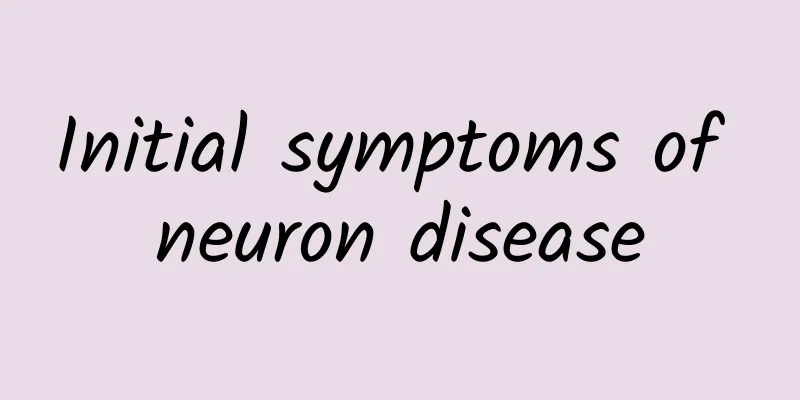Initial symptoms of neuron disease

|
Neuron disease is a type of damage to motor neurons, which can have a great impact on a person's motor ability. In severe cases, it can lead to paralysis. Therefore, when this disease occurs, it must be treated in time. The initial symptoms of this disease are now more common in the hands. Patients often feel that their fingers are powerless, and they will experience stiffness and clumsiness. Initial symptoms of neuron disease The main manifestations of this disease are that the earliest symptoms are mostly seen in the hands. Patients feel weakness, stiffness, and clumsiness in finger movements, and the hand muscles gradually atrophy, and fasciculations can be seen. Progressive muscular atrophy occurs in the distal extremities. In more than half of the cases, the early stage is atrophy of the thenar and hypothenar muscles of one upper limb. Later, it spreads to the forearm muscles and even the pectoralis major muscles. The back muscles and calf muscles may also atrophy. Muscular atrophy causes limb weakness, high muscle tone (stretching sensation), fasciculations, difficulty in movement, breathing and swallowing disorders, etc. If the bilateral pyramidal tract is affected in the early stage, spastic paraplegia of both lower limbs may appear first. It has caused serious harm to the patient's physical and mental health. The symptoms of motor neuron disease are very obvious in the early stages, first appearing in the hands. Patients will feel stiff fingers, clumsiness, motor weakness, gradual atrophy of hand muscles, and visible fasciculations. Limb weakness, increased muscle tension, difficulty walking, tightness, and clumsy movements. However, this phenomenon belongs to the upper motor neuron type, which usually starts in adulthood and generally progresses very slowly. This is also one of the symptoms of motor neurone disease, which everyone needs to understand. Tongue muscle atrophy may also occur, accompanied by tremors, resulting in unclear pronunciation, difficulty swallowing, and weakness in chewing. In the late stage, muscles throughout the body may atrophy, causing the patient to be bedridden, and respiratory insufficiency may occur due to paralysis of the respiratory muscles. This type of motor neuron disease is called lower motor neuron disease. Causes 1. Genetic factors: More than ten mutant genes related to the onset of ALS have been discovered. The most common one is the superoxide dismutase 1 gene (SOD1), followed by FUS and TARDBP. The others include ALS2, SETX, VAPB, ANG, OPTN, ATXIN2, etc. But the first three genes were associated with most ALS, while the remaining large number of genes were only associated with a few ALS. All mutated genes of familial ALS can appear in sporadic ALS patients. The only clinical difference between the two groups is that the former has a younger age of onset, about 10 years earlier than the latter. In addition, first-degree relatives of sporadic ALS patients have an increased risk of developing ALS and other neurodegenerative diseases. Therefore, it cannot be ruled out that genetic factors also play a role in sporadic ALS. These mutated genes related to the onset of ALS mainly include SOD1, Alsin gene, TARDNA binding protein gene, sarcoma fusion gene (FUS/TLS), VAMP-associated protein type B gene (VAPB), angiopoietin gene (ANG), Ataxin-2 (ATXN2), ubiquitin protein 2 gene (UBQLN2), C9orf72-related ALS, etc. 2. Environmental factors Based on a large number of epidemiological surveys, people have found many environmental factors related to the onset of ALS, including heavy metals, pesticides, herbicides, trauma, diet and exercise. But generally speaking, there is no connection between these factors, and whether they are necessarily related to the occurrence of ALS and the mechanism by which they cause the occurrence of ALS also need further confirmation. Environmental factors associated with the onset of ALS include agricultural labor and rural life, electric shock, ionizing radiation, trauma, excessive exercise, smoking, industrial raw materials, heavy metals, etc. |
<<: What are the symptoms of spina bifida occulta
>>: What are the symptoms of eye cream allergy
Recommend
What are the dangers of cervical thread embedding
Nowadays, since people need to use computers and ...
Can glucose cure jaundice?
Jaundice is a common phenomenon in newborns. It i...
Pain under the right armpit
People should know that pain in the right armpit ...
What is varicose vein?
Varicose cord is a disease that men may suffer fr...
What light dishes should I eat when I have diarrhea?
Diarrhea is commonly known as "diarrhea"...
How to eat Schisandra chinensis for good effect
Schisandra is actually a plant of the Magnoliacea...
Diagnosis and treatment of common anorectal diseases
Anorectal diseases are relatively common in life....
How to store Chinese herbal medicine decoction
When some patients take Chinese medicine, they wi...
Several commonly used medicinal liquors for traumatic injuries
1. Red Flower Rhubarb Wine Recipe: equal parts of...
What are the symptoms and treatments of pancreatitis?
Pancreatitis is a relatively common disease. Once...
What should I do if my fingers are swollen and painful due to rheumatoid arthritis?
Rheumatoid arthritis is also known as rheumatoid ...
What is tongue coating? What causes dark red tongue coating?
As our quality of life improves, our food consump...
The benefits of hot water foot bath, a good way to maintain health
Many people like to take foot baths. Soaking feet...
Why do beans cause milk to return?
I often hear people from the older generation say...
Will I have miscarriage if I am more than five months pregnant?
Women will feel uncomfortable when they are pregn...









